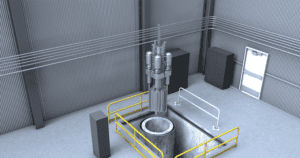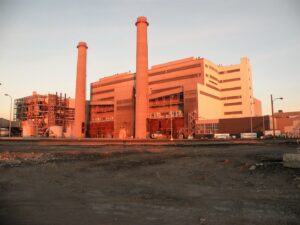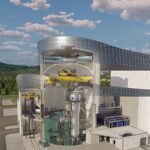
The UK has confirmed that Wylfa on the island of Anglesey, North Wales, will host three Rolls-Royce small modular reactors (SMRs) that could deliver first power in the mid-2030s—launching a state-backed, fleet-based nuclear deployment through publicly owned entity Great British Energy–Nuclear (GBE-N). The UK government has framed the SMR project, which is underpinned by more than £2.5 billion in government funding, as the foundation of a UK sovereign SMR capability with export potential.
The decision, unveiled on Nov. 13 by GBE-N, the Department for Energy Security and Net Zero, and the Prime Minister’s Office, envisions that Wylfa on the coast of Ynys Môn will host “the UK’s first small modular reactor nuclear power station.” The site is envisioned to comprise an initial deployment of three 470-MWe Rolls-Royce SMRs, though “Great British Energy-Nuclear assesses the site could potentially host up to 8 mini reactors,” the government said.
Simon Bowen, freshly announced as GBE-N chair, suggested the fleet-based deployment “is designed to attract private investment, strengthen the UK supply chain, and reduce reliance on imported energy.”
GBE-N is slated to begin site activity in 2026. The entity’s “ambition is for Wylfa’s small modular reactors to be supplying power to the grid from the mid-2030s,” the government said. GBE-N has said it will now continue “to engage with local communities and stakeholders to ensure the project delivers lasting value and maintains public trust.”

A Big Leap for Rolls-Royce
GBE-N first selected Rolls-Royce SMR on June 10 as its preferred bidder “to build the country’s first small modular reactors,” following what the government described as a “rigorous two-year competition to select nuclear technology for UK deployment.” Rolls-Royce contended with several major SMR vendors in that competition, which launched in July 2023. The government in September 2024 shortlisted four companies, narrowed from six announced in March 2024: Westinghouse, GE-Hitachi Nuclear Energy, Holtec Britain, and Rolls-Royce SMR. Rolls-Royce was notably the only UK “home-grown” technology.
But the June 10 unveiling also coincided with the reconstitution of Great British Nuclear as Great British Energy–Nuclear, a publicly owned entity tasked with delivering the SMR program alongside Great British Energy. The government at the time pledged “over £2.5 billion” for the SMR program in the current spending period.
The SMR program is part of the UK’s broader strategy to expand nuclear capacity to 24 GW by 2050 and to reassert public ownership in major nuclear projects. Alongside the Wylfa announcement, the government tasked GBE-N to identify potential sites for another large-scale plant beyond the 3.2-GW Hinkley Point C project and the 3.2-GW Sizewell C station—a sister EPR project that reached final investment decision in July 2025 and made the UK the largest shareholder, holding 44.9% of the equity.
GBE-N is expected to report back by fall 2026 on the next UK nuclear project. The Energy Secretary has requested that the assessment include sites across the UK, including Scotland. However, according to the government, “any further large-scale project, subject to future policy decisions, would be similar in scale to the Hinkley Point C or Sizewell C projects, with the potential to power the equivalent of 6 million homes.”
A Potentially Quick Build?
The Rolls-Royce SMR is a 470-MWe, three-loop pressurized water reactor (PWR) that “draws upon standard PWR technology that has been used in hundreds of reactors around the world,” according to a design overview white paper submitted to the U.S. Nuclear Regulatory Commission in July 2025. The reactor is designed to deliver 1,358 MWth with a 60-year design life and incorporates both passive and active safety systems, each with substantial internal redundancy. The design uses industry-standard uranium dioxide fuel enriched to no greater than 4.95% uranium-235, arranged in a 17×17 assembly with 121 fuel assemblies, and refueling cycles of 18 to 24 months. Unlike other PWRs, the Rolls-Royce SMR does not use soluble boron for routine reactivity control. Core control is achieved through control rod movement (89 control rods) and burnable gadolinia poisons distributed in the fuel. The company notes that this “removes the requirement for soluble boron,” which simplifies operations, eliminates boron dilution accidents, and reduces liquid radioactive waste.
The company’s shining attribute is a factory-led construction model, scaled for its 470-MWe capacity size—which makes it one of the larger SMRs under development globally. “The whole power station is constructed using around 1,500 standard transportable modules manufactured and tested in off-site factories to minimize activity on site,” it says.
The company’s road transportable modules—grouped into heavy-pressure-vessel assemblies, mechanical/electrical/plumbing units, and civil structures—are assembled within a covered “Site Factory,” a temporary construction shelter that isolates the site from weather and the surrounding environment from construction impacts. Documents suggest the combined Reactor Island and Turbine Island footprint is 19,189 square meters (4.7 acres), with a primary plant area inside an earth berm of 100,000 square meters (24.7 acres). The total disturbed area during construction, including parking and laydown, is approximately 450,000 square meters (111.2 acres) for the indirect-cooled baseline design. The compact footprint is intended to minimize civil complexity and “reduce risk and provide certainty with a factory-built product.”

Rolls-Royce SMR also positions its licensing architecture as a strategic differentiator through an integrated E3S Case—a combined Environment, Safety, Security, and Safeguards package—that aligns with IAEA SSG-61 and U.S. NRC NUREG-0800 standards to streamline both domestic and export licensing. The company says that the digitalized, modular structure is intended to “increase our licensing flexibility when exporting Rolls-Royce SMRs outside of the UK,” which would allow the generic case produced during the UK Generic Design Assessment (GDA) to be rapidly adapted into site-specific Pre-Construction Safety Reports (PCSRs) or tailored to international regulatory frameworks.
So far, the Rolls-Royce SMR’s 470-MWe design is currently the most advanced SMR in the UK’s GDA process, which is conducted jointly by the Office for Nuclear Regulation (ONR), the Environment Agency, and Natural Resources Wales. The company completed GDA Step 1 (Initiation) in March 2023 and Step 2 (Fundamental Assessment) in July 2024, with no fundamental environmental protection shortfalls identified. Step 3 (Detailed Assessment) commenced in July 2024 and is planned for completion by December 2026.
The company also has a developing fleet outside the UK. ČEZ, the Czech Republic’s largest public company, selected Rolls-Royce SMR as its preferred technology partner in September 2024 and acquired a 20% stake in the company. In July 2025, the two parties signed an Early Works Agreement to advance deployment at the Temelín site. The first Czech SMR is expected to be built in the mid-2030s, though ČEZ has indicated interest in deploying up to 3 GW of SMR capacity across multiple locations.
A Burgeoning UK SMR Scene, Bolstered by Atlantic Nuclear Push
The UK government has indicated that the Wylfa decision “doesn’t close the door” to other SMR developers. Outside the government-led Wylfa and GBN SMR competition tracks, several privately driven projects are advancing in parallel. American firm Last Energy has announced plans to deploy four 20-MWe PWR‑20 microreactors at the former Llynfi coal plant site in Bridgend, South Wales, targeting first power by 2027, and has formally entered the UK nuclear site licensing process with the Office for Nuclear Regulation. Westinghouse and Community Nuclear Power have agreed to pursue a privately financed fleet of AP300 SMRs in North Teesside under a February 2024 project memorandum, while Holtec Britain is progressing its SMR‑300 PWR with UK grant support under the Future Nuclear Enabling Fund.
As POWER has reported, domestic efforts are now being amplified by an unprecedented wave of U.S.–UK nuclear cooperation formalized under the Atlantic Partnership for Advanced Nuclear Energy, which triggered more than $100 billion in commercial nuclear agreements across advanced reactors, fuel supply chains, waste management, and engineering services between Sept. 14–24, 2025. That period saw a coordinated suite of deals—Centrica and X-energy’s plan to deploy up to 12 Xe-100 high-temperature gas-cooled AMRs at Hartlepool (with an ambition for up to 6 GW across the UK), Holtec International, EDF UK, and Tritax’s MOU to pursue SMR‑300 units at the former Cottam coal station for data center loads, and Last Energy and DP World’s agreement on a port-centric PWR‑20 microreactor at London Gateway—all designed to pair new nuclear with energy‑intensive industrial and digital infrastructure loads.
The Atlantic framework also seeks to accelerate licensing and export pathways. While Rolls-Royce SMR disclosed that it entered the U.S. regulatory process by submitting an engagement plan to the NRC in April 2025, U.S. developer TerraPower and KBR agreed to explore potential UK sites for the Natrium reactor. Major engineering, procurement, and construction firms—Bechtel, Fluor, AtkinsRéalis, and Framatome—announced new U.S.–UK cooperation frameworks focused on modular nuclear construction, long-lead procurement, and harmonized design standards. Several agreements directly pair EPC firms with advanced reactor vendors: Bechtel with X-energy at Hartlepool, Holtec with Framatome and Arabelle Solutions at Cottam, and Fluor expanding AP300 engineering support with UK suppliers. Notably, U.S. engineering firm Amentum announced a major expansion of its UK nuclear workforce and waste management footprint, underscoring the deepening integration of transatlantic supply chains and delivery models.
Wylfa’s Nuclear Legacy
As POWER has reported, Wylfa holds a storied place in British nuclear history and has emerged as a focal point for the UK’s nuclear revival. The site hosted the Wylfa Nuclear Power Station, which began operation in 1971 as the UK’s largest plant running on twin 490-MWe Magnox reactors, generating 1,000 MWe of capacity—enough for 40% of Wales’ total electricity needs at the time. Reactor 2 ceased operation in April 2012, while Reactor 1, the world’s last operating Magnox reactor, closed permanently in December 2015 after 44 years of operation. The site is now undergoing decommissioning under the Nuclear Decommissioning Authority.
The UK government acquired the Wylfa site in March 2024 following the collapse of Hitachi’s Wylfa Newydd project—a proposed £20 billion development featuring two UK Advanced Boiling Water Reactors that was formally canceled in January 2021 after Hitachi withdrew from the UK new-build market. Great British Nuclear’s acquisition of the Wylfa and Oldbury sites marked the first time the government acquired land for new nuclear since the 1960s. In May 2024, notably, the government designated Wylfa as its preferred site for a third large-scale nuclear power plant beyond Hinkley Point C and Sizewell C. The UK government has indicated that its selection was influenced by economic benefits for the region and by Wales’s longstanding nuclear history, including the two Magnox reactors at Trawsfynydd that operated between 1965 and 1991.
—Sonal Patel is a POWER senior editor (@sonalcpatel, @POWERmagazine).










